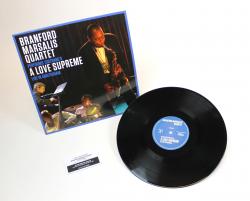 Coltrane’s A Love Supreme: Live in Amsterdam reissue from the Branford Marsalis Quartet out now and available on vinyl for the very first time Read more »
Coltrane’s A Love Supreme: Live in Amsterdam reissue from the Branford Marsalis Quartet out now and available on vinyl for the very first time Read more »
Songs of Mirth and Melancholy Review
Publication: All Music
Date: June 5, 2011
Author: Thom Jurek
Given the history that saxophonist Branford Marsalis and pianist Joey Calderazzo have, the end results of Songs of Mirth and Melancholy should not be surprising, yet they are. Calderazzo replaced the late Kenny Kirkland in Marsalis’ band in 1998 and the rapport between them is seamlessly intuitive as revealed here. Cut in three days in Durham, North Carolina, the set contains compositions by both men, as well as a surprising pair of covers. As the title implies, this is a study in mood contrasts, and it begins on an up note with Calderazzo’s rollicking “One Way.” The pianist populates the space with a swinging, Monk-ish series of chords that employs his own love of of stride right down the line. Marsalis’ tenor is a tough vocal in its responses to the the blocky chordal melody, playing brief choppy phrases that nearly honk. The saxophonist’s “The Bard Lachrymose,” is a tender, moody, emotionally expressive ballad, on which Marsalis plays soprano. It’s nearly an art song, episodic as a perfect intro to Calderazzo’s ballad “La Valse Kendall,” with its own ringing middle-register chords and upper-register responses. The soprano is utterly mournful, like a spurned lover reacting to his send-off. “Face on the Barroom Floor” is a tune Wayne Shorter wrote for Weather Report’s Sportin’ Life album. Marsalis’ economy on the soprano horn reflects the composer’s own blowing, but more than this, he digs out the subtler aspects in its melody as Calderazzo colors inside the lines, shading them a deeper hue of blue. The saxophonist’s “Endymion” is a near-classical composition with gorgeous counterpoint and elements of swing from Calderazzo that precede a tender reading of an early song by Brahms. The closing number, “Bri’s Dance,” by the pianist, illustrates the knotty twists and turns he’s capable of in both his formal structures and in relation to Marsalis in improvisation, who uses his soprano as a contrapuntal instrument, revealing the depth of field that these players listen to one another in. While many duet recordings offer two players working off a series of melodies and changes, Songs of Mirth and Melancholy is an exercise in genuine harmonic and rhythmic invention.
Categories
Tags in Tags
Branford Marsalis Branford Marsalis Quartet ellis marsalis four mfs playin' tunes Joey Calderazzo Justin Faulkner Marsalis Family marsalis music metamorphosen miguel zenon music redeems new orleansFilter by Artist
Marsalis Music Radio
Join Our Mailing List
- RT @bmarsalis: Compliments of the @T_Blanchard archives. https://t.co/4RsXbyEloa — 3 years 8 weeks ago MarsalisMusic